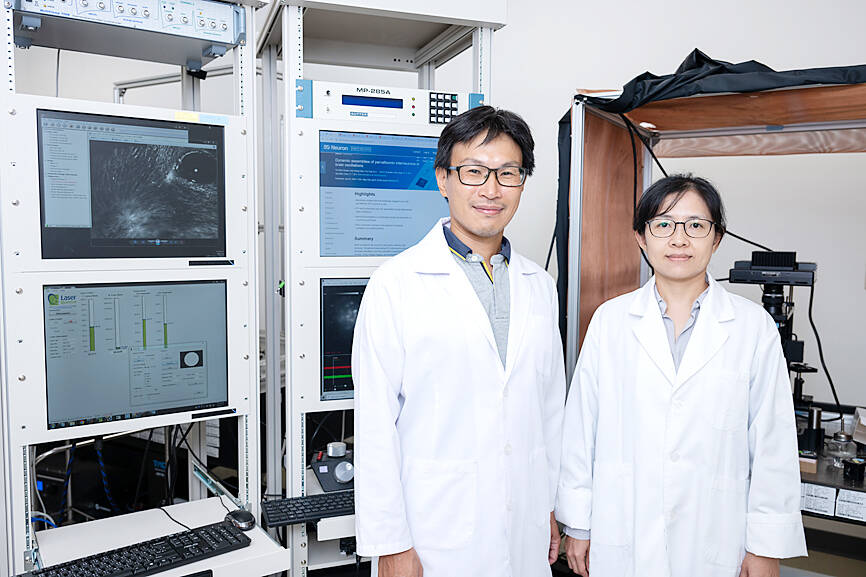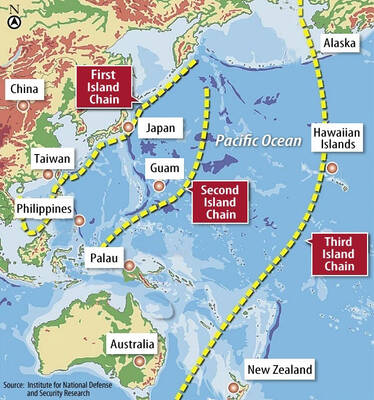A National Yang Ming Chiao Tung University (NYCU) research team has developed a technique to observe the interactions of interneurons in live animals under the microscope.
NYCU Institute of Neuroscience assistant professors Chen Tsai-wen (陳摘文) and Lin Bei-jung (林貝容) led the team, whose research was published this month in the scientific journal Neuron.
“Interneurons are relatively rare nerve cells,” Lin said in a statement. “In the past, scientists could only sporadically observe the transmission of electrical signals from the interneuron cells through implanted electrodes.”

Photo courtesy of National Yang Ming Chiao Tung University
She described the previous research as “finding needles in haystacks,” as scientists could only record one interneuron a month.
There was not a viable way to observe interneurons, she said.
The team developed a technique combining voltage imaging and fluorescent protein technologies, allowing them to record up to 26 interneurons in experiments, she said.
“Our research team found that interneurons do not activate randomly, but tend to do so together to generate action potential to transmit signals, and they seem to be able to find ‘like-minded friends’ to transmit electrical signals together,” Lin said.
Chen said that interneurons are cells that control the transmission of inhibitory nerve conduction in the brain and are closely related to the formation of brain waves.
“Brain waves derive from the potential changes from the synapses of nerve cells. Resonance of a certain number of cells must occur before brain waves can be recorded from the scalp,” he said. “The interesting thing about interneurons is that we can see from a microscope that they tend to find their partners and work together even if they have yet to reach the threshold for action potential.”
The research team used the self-developed technique to directly observe the collective actions of nerve cells of live animals, the university said.
“Their study shows the complicated way cranial nerves work together, which is crucial in understanding how the brain functions,” it said.

WANG RELEASED: A police investigation showed that an organized crime group allegedly taught their clients how to pretend to be sick during medical exams Actor Darren Wang (王大陸) and 11 others were released on bail yesterday, after being questioned for allegedly dodging compulsory military service or forging documents to help others avoid serving. Wang, 33, was catapulted into stardom for his role in the coming-of-age film Our Times (我的少女時代). Lately, he has been focusing on developing his entertainment career in China. The New Taipei District Prosecutors’ Office last month began investigating an organized crime group that is allegedly helping men dodge compulsory military service using falsified documents. Police in New Taipei City Yonghe Precinct at the end of last month arrested the main suspect,

A cat named Mikan (蜜柑) has brought in revenue of more than NT$10 million (US$305,390) for the Kaohsiung MRT last year. Mikan, born on April 4, 2020, was a stray cat before being adopted by personnel of Kaohsiung MRT’s Ciaotou Sugar Refinery Station. Mikan was named after a Japanese term for mandarin orange due to his color and because he looks like an orange when curled up. He was named “station master” of Ciaotou Sugar Refinery Station in September 2020, and has since become famous. With Kaohsiung MRT’s branding, along with the release of a set of cultural and creative products, station master Mikan

Eleven people, including actor Darren Wang (王大陸), were taken into custody today for questioning regarding the evasion of compulsory military service and document forgery, the New Taipei District Prosecutors’ Office said. Eight of the people, including Wang, are suspected of evading military service, while three are suspected of forging medical documents to assist them, the report said. They are all being questioned by police and would later be transferred to the prosecutors’ office for further investigation. Three men surnamed Lee (李), Chang (張) and Lin (林) are suspected of improperly assisting conscripts in changing their military classification from “stand-by

LITTORAL REGIMENTS: The US Marine Corps is transitioning to an ‘island hopping’ strategy to counterattack Beijing’s area denial strategy The US Marine Corps (USMC) has introduced new anti-drone systems to bolster air defense in the Pacific island chain amid growing Chinese military influence in the region, The Telegraph reported on Sunday. The new Marine Air Defense Integrated System (MADIS) Mk 1 is being developed to counter “the growing menace of unmanned aerial systems,” it cited the Marine Corps as saying. China has constructed a powerful defense mechanism in the Pacific Ocean west of the first island chain by deploying weapons such as rockets, submarines and anti-ship missiles — which is part of its anti-access/area denial (A2/AD) strategy against adversaries — the